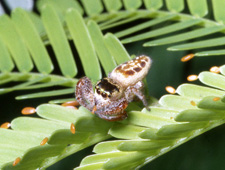Eric Olson's along came a spider story
The biologist makes a discovery that takes years to be discovered

Bagheera kiplingi
The story of the world’s first vegetarian spider appeared last week in numerous newspapers and other media, including the New York Times, the Boston Globe, on BBC radio, and on dozens of science and news websites. The public’s interest in the news of the bug-eyed and furry Bagheera kiplingi (named after the panther in "The Jungle Book") revealed a healthy appetite for the novel and quirky in the 40,000-species strong arachnid universe. But the story also reveals how we sometimes miss what’s important—despite its proximity right under our noses.
The known story of B. kiplingi goes back at least to 1896, when a Wisconsin taxonomist, who never actually saw the species in its native tropical habitat, gave the multi-colored spider its name. But then the jumping spider, which relies on hydraulically powered legs to go the distance, seems to have been largely ignored. Daniel Janzen, a luminary of tropical ecology and a specialist on plant-insect interactions, collected some specimens of the spider during his groundbreaking dissertation research on ant acacia trees in Mexico, but did not note anything unusual about the spider’s biology.
Fast forward to the jungles of Central America in 2001. Brandeis biologist Eric Olson had already spent two years researching spiders and herbivorous insects, and their host plant interactions, in the tropical dry forests of northwestern Costa Rica. To build an inventory of spiders he relied on Earthwatch volunteers to go out and find specimens for him to identify. But he advised them to avoid the ant acacia plant, home to colonies of stinging ants that cause impressive welts.
Stinging ants and their host, the acacia plant, represent one of the most famous textbook examples of mutualistic symbiosis—the phenomenon of two species essentially creating a compound organism to such an extent that they can no longer live independent of each other. Here’s how it works in this case: acacia ants raise their young in the thorns of the plant, and worker ants roam around on the plant both day and night defending it from all manner of insects—beetles, grasshoppers and the like—who would otherwise devour it. In return, the defending ants harvest the plant’s tiny little leaf tips known as Beltian bodies, which provide all the food needed by the ant larvae.
In warning his research assistants away from the acacia, Olson merely reflected the conventional scientific wisdom that it would be suicidal for meat-eating spiders to run the gauntlet of stinging ants on the acacia.
But Olson, who also teaches sustainable development at the Heller School, dispatched that assumption with an important discovery. In an email last week to Boston Globe reporter Beth Daly, he explained how it happened: “One day a vial came in containing a spider they had indeed been collected on an ant acacia tree. So I asked these sweet volunteers of mine, 'what in the world were you looking at ant acacias for, during this spider survey?' I asked this because I just 'knew' that no spider could possibly exist on this tree. And the answer was, they were just watching the ants, for fun really, and by chance they noticed a jumping spider at the same time. So fine, a spider had been found on an ant acacia, well this was still early in the spider inventory work I was conducting, so (since no spider could possibly exist on ant acacias) I figured 'this is just a fluke, it must have fallen on the plant from above just before the people found it'—and I went on with my business.
“Some weeks later it happened again, and one of my field assistants called me outside and said, 'C’mon boss, let’s go see what that spider is doing,' and so I went, and watched, and within about 5 minutes ZOUNDS! it suddenly grabbed a Beltian body—solid plant tissue!—and ran off with it. I remember going into the lab at that point and announcing 'Yo! See this animal, this animal shall from today and for all time be known as the Ant Acacia Jumping Spider!'”
Olson says the discovery challenges two basic rules of spider biology. First, spiders don’t eat plant tissue, or if they do its only an incidental part of their diets (for example a spider might sip nectar instead of a rain drop when thirsty). Second, spiders don’t identify with a particular plant species the way herbivorous insects tend to do (think monarch butterfly only laying eggs on milkweeds). But here is a spider that actually has a host plant, where it is easily found even while being extremely rare on all surrounding vegetation. How the spiders disperse and find new ant acacia mutualisms to annoy is still not well understood.
For years after his discovery, Olson tried to publish this remarkable story in top journals, all to no avail. In an interesting example of scientific mutualism, the spider was rediscovered in Mexico by Christopher Meehan, then a grad student at Villanova, and Meehan and Olson partnered on publishing. Amazingly, yet more failure to get the story out continued, until finally the study was published Oct. 14 in the journal Current Biology.
“The moral of the story is that truly exceptional phenomena can go overlooked for a long time,” said Olson.





